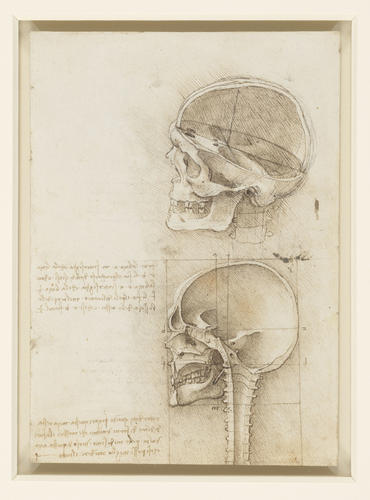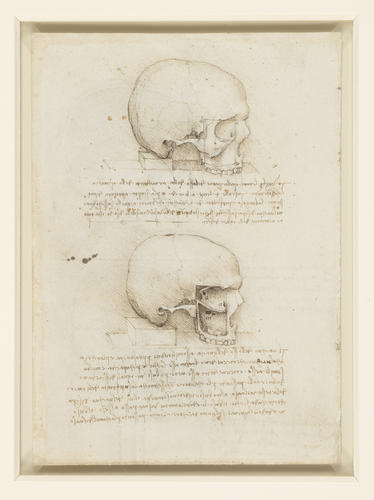-
1 of 253523 objects
Recto: The skull sectioned. Verso: The cranium 1489
Traces of black chalk, pen and ink | 18.8 x 13.4 cm (sheet of paper) | RCIN 919057

Leonardo da Vinci (1452-1519)
Recto: The skull sectioned. Verso: The cranium 1489

Leonardo da Vinci (1452-1519)
Recto: The skull sectioned. Verso: The cranium 1489


-
For Leonardo's skull studies of 1489, see RCIN 919059.
Both drawings on the recto give the location of the senso comune, the supposed confluence of the senses within the brain (cf. 912626, 912603). The upper drawing places it at the intersection of three orthogonal lines—an anterior-posterior axis, a vertical axis through the upper point of the skull, and a lateral axis roughly along the ridge of the dorsum sellae. Just in front of this intersection are the optic foramina; at the front of the orbit is the fossa for the lacrimal sac, and Leonardo’s attention to detail can be seen in the inclusion of the small zygomaticofacial foramen on the zygomatic arch (the dot on the cheekbone).
The lower drawing on the recto shows the skull in a full sagittal section, with the cervical vertebrae included schematically. The grid and accompanying notes locate the senso comune at the intersection of the lines am and cb (at the mid-point of the height of the skull), and the ‘fulcrum of the cranium’ at the intersection of the lines rm and hf (at one-third of the height of the skull, though the grid seems to show it at one-quarter). Of the many features accurately depicted, one may note the prominent frontal sinus; the optic nerve emerging from the optic foramen; the internal acoustic meatus and hypoglossal canal; the inferior alveolar nerve entering the mandibular foramen; the incisive canal piercing the anterior hard palate; and the opening of the nasolacrimal canal into the nasal cavity. It appears that a portion of the inferior nasal concha was removed to reveal the ostium of the nasolacrimal canal, and the middle and superior nasal conchae appear similarly to have been left off to indicate the opening into the maxillary sinus – this is somewhat large and the ethmoidal bulla is only vaguely indicated, and possibly this area was damaged during the preparation of the skull. The dorsum sellae and crista galli are omitted.
The two drawings on the verso show a cranium as if resting on a table, supported by a block under the occipital bone. There is no one angle of view: some features are seen as if from slightly above, some from slightly behind, and some from slightly to the front. Among other features, Leonardo has shown the suture lines of the major cranial bones, the infratemporal crest, the pterygopalatine fossa, the sphenopalatine foramen, and the foramen for the zygomaticofacial nerve on the face of the zygomatic bone.
In the second drawing Leonardo has removed the lateral orbital wall and the lateral portions of the zygomatic and maxilla bones, using the superior and inferior orbital fissures as targets for his saw cuts. We now see the full depth of the orbit, with the optic foramen at b and the fossa for the lacrimal duct at n; and the maxillary sinus (whose first description is usually credited to Nathaniel Highmore in his Corporis humani disquisitio anatomica of 1651), with openings into the middle meatus of the nasal cavity at m. On the floor of the sinus are small elevations, like stalagmites in a cave; these are portions of the thin capsule of alveolar bone covering the roots of the maxillary teeth (particularly noticeable in older individuals).
The notes record physiological interpretations of these structures based on the ancient theory of the humours: the ethmoid bone ‘discharges superfluous humours of the head into the nose’; the maxillary sinus contains ‘the humour that nourishes the roots of the teeth’; and the lacrimal fossa is ‘the place through which the tears rise up from the heart [seat of the emotions] to the eye, passing through the canal of the nose’.
Text adapted from M. Clayton and R. Philo, Leonardo da Vinci: Anatomist, 2012, no. 12Provenance
Bequeathed to Francesco Melzi; from whose heirs purchased by Pompeo Leoni, c.1582-90; Thomas Howard, 14th Earl of Arundel, by 1630; probably acquired by Charles II; Royal Collection by 1690
-
Creator(s)
Acquirer(s)
-
Medium and techniques
Traces of black chalk, pen and ink
Measurements
18.8 x 13.4 cm (sheet of paper)
Category
Object type(s)
Other number(s)